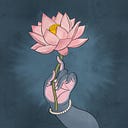The Birth of Kṛṣṇa
Inscriptions from the Kushana period (1st to 3rd century CE) point to the continuity of Kṛṣṇa worship, and one of the first iconographic representations of Kṛṣṇa is a stone bas-relief found near Mathura, dated to the early 1st century which shows Kṛṣṇa being carried across the river Yamuna after his birth by his father Vasudeva.
By the first century BC, Kṛṣṇa worship had already taken root in India, and by the time of the Guptas, who were self-proclaimed Vaisnavas, it was well-established across the country. In fact, multiple Gupta rulers referred to themselves as “paramabhāgavatas”, or supreme devotees of Bhagavan. It was also at the peak of the Gupta era, regarded the golden age of literature, dramaturgy, sculpture, art, architecture, and other aesthetic expressions, that the Puraṇic literary genre attained its final stages of compilation, and it is in these texts that the story of Kṛṣṇa reaches its fullest expression. Of these numerous texts, the Bhāgavata perhaps retains the topmost position, having inspired more derivative literature, poetry, drama, dance, theater, and art than any other text in the history of Sanskrit literature, with the possible exception of the Rāmāyaṇa. As a text, the Bhāgavata presents itself not just as a record of sacred history but as a literary substitute for Kṛṣṇa after his departure from the world — the vangamayavatara, or literary incarnation of God. In fact, the concluding verse of the tenth book says that, by reading, hearing, and reciting the text itself, one is interacting directly with God, and at the very end of the purāṇa, it is stated that those born after the departure of Kṛṣṇa from the world, who are fortunate enough to encounter the Bhāgavata purāṇa, listen to it, read it, and contemplate it constantly with a devoted heart shall attain liberation, just as those who were fortunate enough to have personally encountered Kṛṣṇa were awarded liberation.
The birth of Kṛṣṇa is described in detail in the Bhāgavata purāṇa as follows.
According to Vedic custom, Nanda Mahārāja called for learned astrologers and brāhmaṇas to perform his son’s birth ceremony.Nanda Mahārāja distributed to the brāhmaṇas 200,000 cows, which were well decorated with cloth and ornaments. He also gave the brāhmaṇas hills of grain decorated with ornaments and golden-bordered cloth. All the assembled brāhmaṇas chanted all kinds of Vedic mantras to invoke good fortune for the child.
Along with this chanting of mantras, bugles and drums sounded auspiciously outside the house. Joyous vibrations could be heard throughout Vṛndāvana. Paintings were made with rice pulp on walls, and scented water was sprinkled everywhere, even on the roads and streets. Ceilings and roofs were decorated with flags, festoons and green leaves. All the cows, bulls and calves were smeared with a mixture of oil and turmeric and painted with auspicious symbols. They wore garlands of peacock feathers and were covered with nice colored cloths and gold necklaces.
When all the ecstatic cowherd men heard that Nanda Mahārāja, the father of Kṛṣṇa, was celebrating the birth ceremony of his son, they became spontaneously joyful. They dressed themselves with costly garments and ornamented their bodies with different kinds of earrings and necklaces and wore great turbans on their heads. They then approached the house of Nanda Mahārāja with gifts. As soon as they heard that Yaśodā had given birth to a child, all the cowherd women became overwhelmed with joy, and they also dressed themselves in costly garments and ornaments. As the dust on the lotus flower exhibits the exquisite beauty of the flower, so did all the gopīs appy the dust of kuṅkuma on their lotus-like faces. The beautiful gopīs took gifts and soon reached the house of Mahārāja Nanda. Overburdened with their heavy hips and swollen breasts, the gopīs could not proceed very quickly, but out of ecstatic love for Kṛṣṇa they hastened to make their way. Their ears were decorated with pearl rings, their necks with jeweled lockets, their lips and eyes with different kinds of lipstick and anointments, and their hands with nice golden bangles. As they were very hastily passing over the stone road, the flower garlands which were decorating their bodies fell to the ground, and it appeared that a shower of flowers was falling from the sky. In this way, they all reached the house of Nanda-Yaśodā and blessed the child: “Dear child, may you live long just to protect us.” While they were blessing child Kṛṣṇa in this way, they offered a mixture of turmeric powder, oil, yogurt, milk and water. They sprinkled this mixture not only on the body of child Kṛṣṇa but on all other persons who were present there.
Nanda Mahārāja was overjoyed to see the happiness of the cowherd men and women, and generously have charity to the different singers assembled there. Some were reciting verses from the Upaniṣads and Purāṇas, some were glorifying the family’s ancestors, and some were singing sweet songs. Nanda Mahārāja, respectfully received everyone present and gave in charity whatever they desired. The learned brāhmaṇas, who had no other source of income and were completely dependent on the vaiśya community for their maintenance, generally received gifts on such festive occasions as birthdays and marriages. Nanda Mahārāja worshipped Lord Viṣṇu on this occasion, desiring that the newborn child Kṛṣṇa would be protected, not knowing that this child was Viṣṇu himself.
References:
- Krishna, A Sourcebook by Edwin Bryant
2. Bhāgavata Purāṇa
__________________________________________
If you find value in my work, I hope you consider becoming a patron or making a contribution to hindu.aesthetic@okicici. Hindu Aesthetic requires a lot of time and effort and your support would mean that I can continue bringing you the best possible content. ❤
